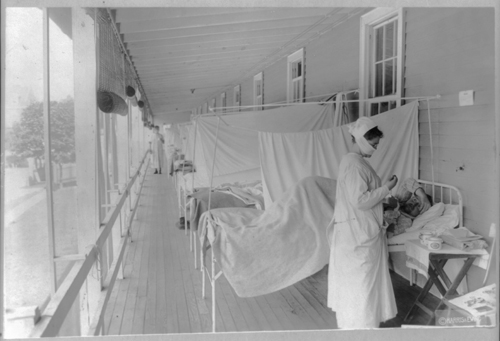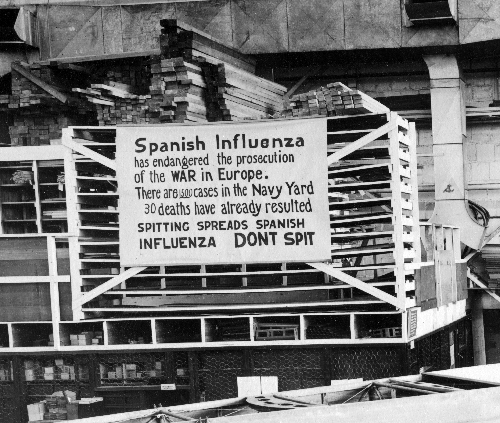Grant Spotlight | July 27, 2022
Share ThisJuly 27, 2022

“We largely forgot about the 1918 flu pandemic. Let’s not forget the COVID-19 pandemic—if not in a memorial sense, then as a lesson in scientific knowledge and social responsibility.” — Nancy Hill, Exhibit Projects Manager & Content Developer, The Mütter Museum at The College of Physicians of Philadelphia
Living through the COVID-19 pandemic presents a unique opportunity to reflect on previous public health crises and how they shaped our lives. Staff at the Mütter Museum at The College of Physicians of Philadelphia was ahead of the times when they started looking into the 1918 flu pandemic a few years ago.
The museum’s research resulted in a collaboration with a historical curator, art curator, and artist group to build on data from over 20,000 death certificates to develop the Spit Spreads Death: The Influenza Pandemic of 1918–19 in Philadelphia exhibition.
Using contemporary art, data analysis, and visualization as a foundation to inspire critical thinking about current and future health issues, the project engages the public in a fuller understanding of the impact and civic responsibility related to pandemics and health crises. It features a film, digital interactives, objects and photographs, personal stories, and contextualized historical and public health information.
Making Contemporary Connections
 Influenza precaution sign at Naval Aircraft Factory, Philadelphia Naval Shipyard, 1918. Photo Credit: U.S. Naval History and Heritage Command Photograph, Catalog # NH 41731-A, Archives Branch, Naval History and Heritage Command, Washington, D.C.
Influenza precaution sign at Naval Aircraft Factory, Philadelphia Naval Shipyard, 1918. Photo Credit: U.S. Naval History and Heritage Command Photograph, Catalog # NH 41731-A, Archives Branch, Naval History and Heritage Command, Washington, D.C. 
After the museum received a grant from the Institute of Museum and Library Services in 2018 to develop the exhibition from the gathered research, Exhibit Projects Manager & Content Developer Nancy Hill joined the team.
Bringing the research to life required a multifaceted project—one that eventually would even include a parade memorializing the victims and health care workers of the 1918 flu pandemic. Data from death certificates and personal stories about the victims served as the backbone for the project.
“When we put out the call for personal stories, we had no idea that we would get such a tremendous response,” Hill said. “So many people have come out of the woodwork with stories of survival or grief that they had not realized were part of a major historical event and a collective social trauma. As difficult as some of these stories can be to hear, people seem to take solace in the fact that their family was not alone, and that an effort is being made to document and memorialize their experiences.”
As this information came together, it became clear that many of the same neighborhoods and demographics impacted in 1918 continue to face public health challenges today. Hill and her team wanted to make sure those communities were included in the programming and resources available through the Spit Spreads Death project.
“We had tables at many community events to talk about influenza past and present, offered free influenza vaccines to the public at multiple events, and organized a health fair in south Philadelphia’s Mifflin Square Park,” Hill added. “Little did we know, the COVID-19 pandemic would make these public health parallels even more relevant just six months after the exhibition opened.”
After they had to close the museum, and before reopening in July 2020, Hill and her team made some changes to the exhibition. This included adding panels explaining that it was completed before the start of the COVID-19 pandemic, changing the context of the copy to no longer be hypothetical, and adding a panel that features a museum member who was on the front lines of the COVID-19 pandemic as a nurse. Press and public interest in the 1918 flu pandemic increased, and the project team’s historical insight was requested by news outlets and visitors alike.
Reflecting on Lessoned Learned
Spit Spreads Death laid a foundation for the public to develop a better understanding of general scientific literacy around public health, epidemiology, the reality of the scientific process, and vaccinations. This foundation has been invaluable to educating the public and positioning the museum as a trusted community resource.
As relevance of the project has increased throughout the current pandemic, the museum team plans to continue public programming around Spit Spreads Death—especially as in-person gatherings become safer. Museum staff also have discussed the possibility of extending the exhibition, as well as exploring public programming that would be relevant to the new set of public health concerns we face today.
“I think it’s important to remind people that pandemics are very serious, but not an apocalyptic event. Towing the line of taking it seriously enough, but not being incapacitated with fear, can be challenging,” Hill said. “This has happened before and will happen again—hopefully not in our lifetime, but it’s important to carry the lessons learned these last few years into all of our personal and public health experiences.”
About the Project
Grant Project Name: Spit Spreads Death
Grant Log Number: MA-10-18-0332-18
Year Awarded: 2018
Recipient: The College of Physicians of Philadelphia
Project Contact:
Nancy Hill
Exhibit Projects Manager & Content Developer
The Mütter Museum at The College of Physicians of Philadelphia
nhill@collegeofphysicians.org
Website: https://collegeofphysicians.org
